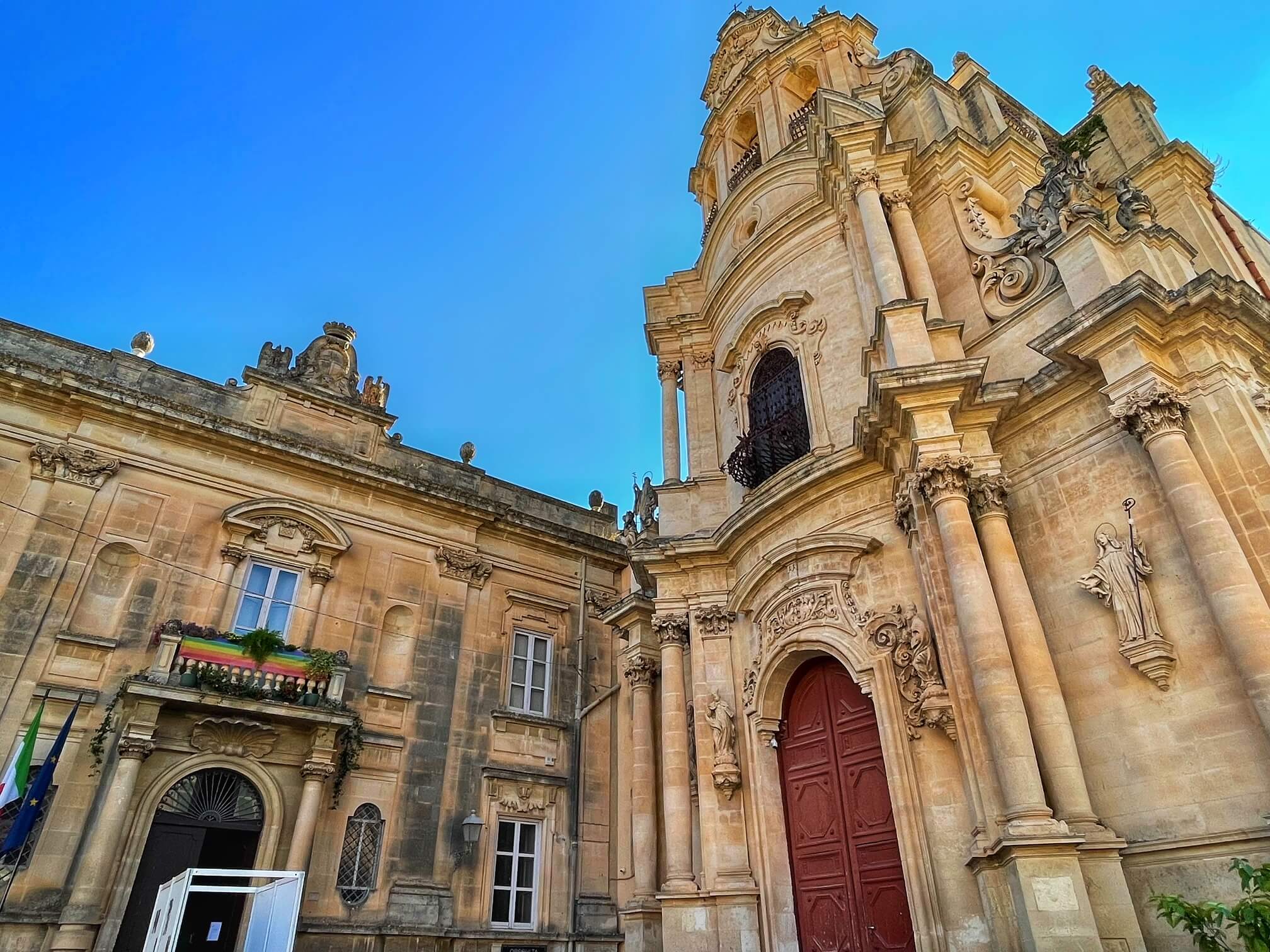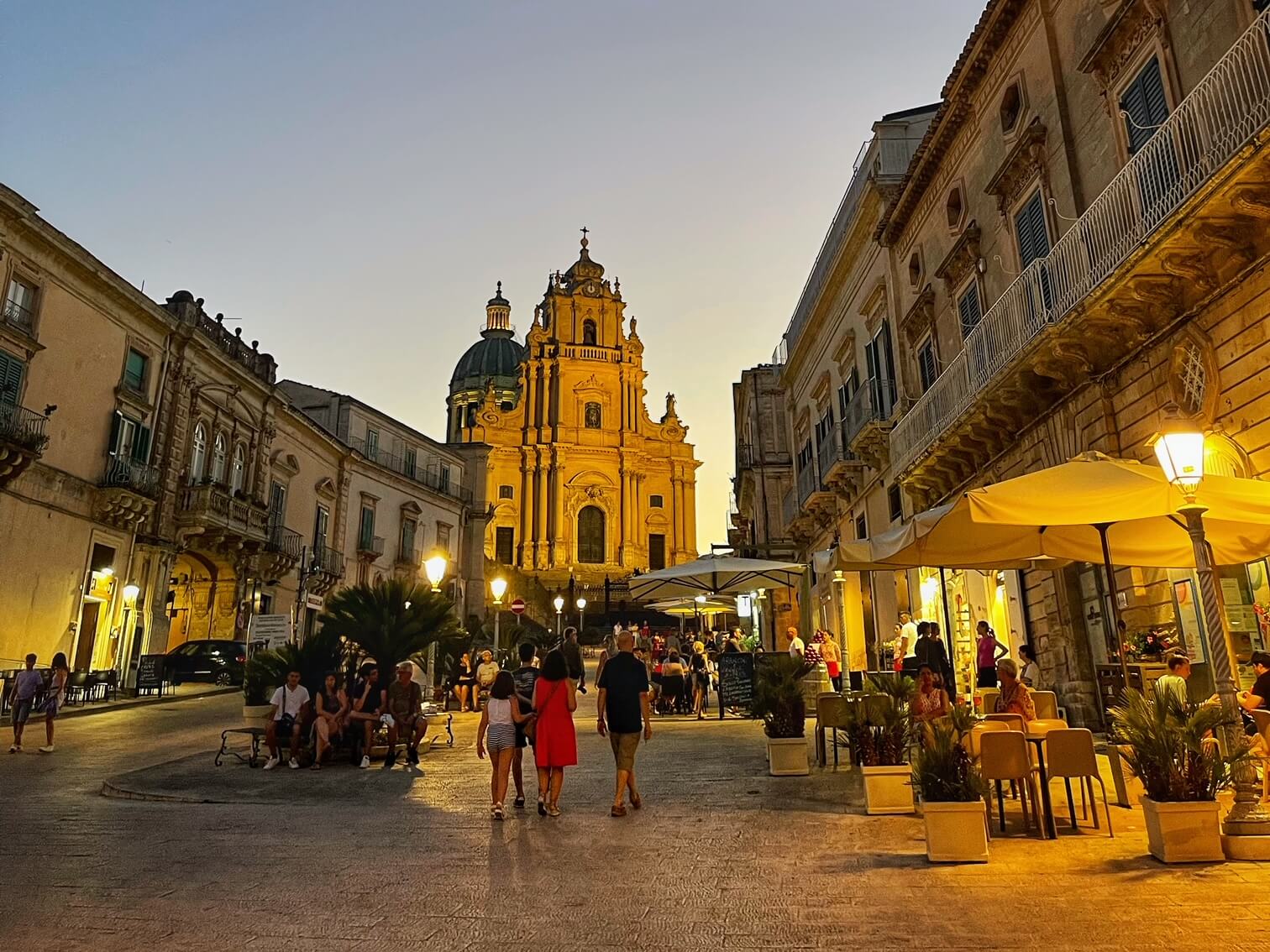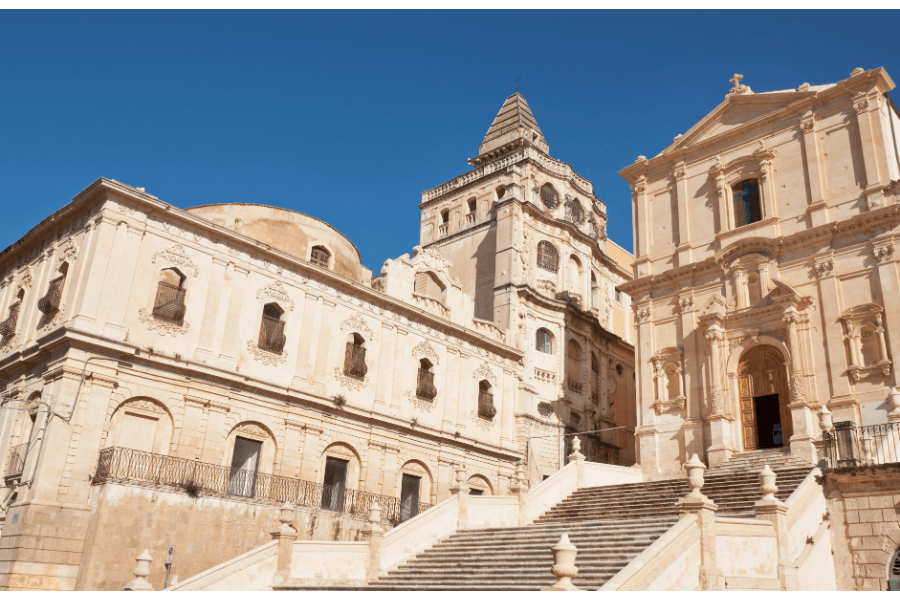Nestled in the sun-drenched landscapes of the Val di Noto in south-eastern Sicily, a series of spectacular small cities embody the unique spirit of the Sicilian Baroque like nowhere else on the island. From the enchanting, honey-coloured palaces of Noto to the elegant beauty of Ragusa and Modica's jaw-dropping cathedral, these incredible UNESCO World Heritage sites were born from tragedy: a powerful earthquake devastated the cities in 1693, but from the ashes and debris of destruction arose the opportunity to recast the cities in a bombastic, up-to-the-minute architectural idiom. Today the Baroque cities of the Val di Noto are not only stunning architectural showcases, but also charming, off-the-beaten path destinations where you can immerse yourself in the captivating rhythms of Sicily. Discover them with us!
Ragusa: A Tale of Two Cities

Spectacularly sited amongst the rocky crags and valleys of the Hyblaean Mountains, Ragusa is the glittering gem of the Sicilian Baroque. Boasting breathtaking landscapes, rich history and splendid Baroque architecture, well-heeled Ragusa is one of Sicily’s top must-visit destinations.
Ragusa is divided into two distinct areas: Ragusa Ibla, the historic lower town, and Ragusa Superiore, the (comparatively) modern upper town. The two parts are separated by a spectacular deep ravine, connected by picturesque bridges and winding streets. The city's unique geography offers panoramic views of the surrounding valleys and hills, making it a photographer's paradise.

Ragusa’s millennial history extends back to antiquity, when it was inhabited by the ancient Siculi tribe. With the arrival of Greek settlers from across the sea, Ragusa and the surrounding area was assimilated into the territory of Magna Grecia. Like the rest of Sicily, Greek culture was eventually supplanted here by the all-powerful Roman empire (after a brief spell under control of the Cathagians), before periods of Byzantine, Arab, Norman and Spanish dominion in turn shaped the fortunes of the city.

An important provincial capital for much of the medieval and early-modern period, Ragusa’s history is inextricably linked with the year 1693. On the morning of January 11th of that year, a massive earthquake of unprecedented magnitude shook the region, leaving a trail of destruction in its wake. With an estimated seismic impact of around 7.4 on the Richter scale, the earthquake was one of the most powerful in recorded European history.

Although the epicentre of the quake was in the coastal city of Catania 100 kilometres away, such was its power that tremors were felt as far away as Naples and Malta. Ragusa, with its precarious location in the peaks and valleys of the mountains, was particularly vulnerable to its shockwaves: in a matter of minutes, buildings crumbled, streets buckled, and over 5,000 citizens were crushed under heaving piles of masonry. The city, one of the beacons of Sicilian society and culture but moments before, was left in ruins.

Out of the tragedy came architectural opportunity: with little left other than smouldering debris, the city emerged as a blank canvas for the brightest lights of Sicilian Baroque architecture to model their ideal urban landscape. With the support of the Sicilian nobility and the Spanish crown, Ragusa's reconstruction took on a monumental scope. The rebuilding process coincided with a flourishing period of artistic and cultural development across Sicily, transforming Ragusa into one of the most fashionable cities in Italy.
The reconstruction led to Ragusa being divided in two: What’s now known as Ragusa Superiore was constructed ex novo, with a regular street plan and buildings constructed in the latest style. The most notable landmark in this part of town is the magnificent cathedral dedicated to Saint John the Baptist, a textbook example of 18th-century ecclesiastical architecture.

But it’s across the gorge in Ragusa Ibla where things get even more spectacular. Although the so-called new town of Ragusa Superiore was constructed on a much safer, disaster-proof site, the surviving Ragusa nobility in the wake of the 1693 earthquake were having none of it, instead deciding to rebuild their decimated palaces stone by stone on the site of the old city. The result is a fascinating fusion of old and new, of medieval and Baroque.

Characterised by its magnificent Baroque architecture of lavish palaces with curving facades, ornate churches with imposing staircases, elegant squares and beautifully designed public gardens, it’s one of the loveliest examples of Baroque town-planning in all of Italy. Don’t miss the Cattedrale di San Giorgio, reached via a sweeping flight of stairs. The Giardino Ibleo, meanwhile, is a flower-strewn public garden studded with temples that offers a splendid views of the hills and valleys of the surrounding Sicilian countryside.
Modica: Baroque Magic and Chocolate Surprises

Just over 10 kilometres from Ragusa, the story of Modica neatly matches that of its neighbour. A fascinating tangle of alleys and piazzas winding up hills and down gorges via steep staircases, like Ragusa Modica also unfolds in two distinct areas: "Modica Alta" (Upper Modica) and "Modica Bassa" (Lower Modica). And like Ragusa, Modica was devastated by the 1693 earthquake before being rebuilt in a spectacular Baroque idiom.

The climb from the more modern lower town up to the dizzying heights of Modica Alta is seriously punishing, but amply repays the effort. Dominating the old town is Modica’s truly jaw-dropping 18th-century cathedral, designed by Rosario Gagliardi. Towering over the surrounding landscape at the top of a punishing 250-step staircase, the cathedral’s three-tiered facade of honey-coloured stone seems to defy gravity as it soars impossibly into the Sicilian sky. Dedicated to Saint George; inside you’ll find an equestrian sculpture of the saint which is carried through the streets on his patron day each April 23rd.

Whilst Rosario Gagliardi’s masterpiece is Modica’s undisputed architectural highlight, there’s plenty more on offer here to make a stop in the city worthwhile. Venture deeper into Modica Alta’s labyrinthine lanes, and you'll discover a treasure trove of palaces rich with faded beauty each of which speaks to the city's aristocratic past. Palazzo Polara, with its grand staircase and opulent frescoes, and Palazzo Failla (now a hotel) are both testament to the city's bygone era of splendour, and offer a glimpse into the luxurious lifestyle of the Sicilian nobility in the 18th century.

For sweet-tooths, Modica is a must-visit destination thanks to its status as one of the world’s great chocolate making hubs. Crafted using traditional methods that were introduced to the city’s artisans in the 1500s by the Spanish, who had learned their secrets from the Aztecs, Modica chocolate is characterised by its granular rather than smooth texture. The secret lies in the cold processing technique, which is said to preserve the true essence of the cocoa beans. Modica chocolate is frequently enriched with classic local flavours, like pistachio, orange, almond and chilli. For a deep dive into the history of chocolate production in Modica, head to the dedicated Museo del Cioccolato - in addition to historical information about the evolution of the product, you’ll find an odd collection of chocolate statues of Italian landmarks including the Colosseum!
Noto: Opulent Palaces and Extravagant Churches

Arguably the ‘big daddy’ of southeastern Sicily’s Baroque cities, the breathtaking beauty of Noto will be sure to leave you lost for words the first time it hives into view. Located 40 kilometres to the southwest of Syracuse, Noto is a dazzling confection of honey-coloured palaces, churches and piazzas all constructed in the ornate Baroque style that characterises 18th-century Sicilian architecture.
Noto’s history is very similar to its neighbours Ragusa and Modica. First settled by the ancient Siculi tribe, over the centuries the city came under the sway of Greek, Roman, Byzantine, Arab and Norman dominion, each contributing to Noto’s complex cultural mosaic.

All that came crashing rudely to earth in the 1693 earthquake. The flourishing medieval city was almost entirely razed to the ground, and more than half of the population lay dead in the streets. Unlike Modica and Ragusa, Noto was rebuilt on an entirely new site 8 kilometres from the ancient foundation, meaning the architects had an entirely free hand in the new urban design, free from the encumbrances of existing buildings and ruins. This explains the remarkable harmony and consistency of Noto’s architecture, laid out on a regular grid by Giovanni Battista Landolina.
 A team of architects led by Roasario Gagliardo and Francesco Sortino gave their imaginations full rein in designing flamboyantly beautiful buildings in the honey-coloured local tufa stone, and its this architectural and artistic splendour that makes Noto so justifiably famous. Like some great open-air museum, stunning edifices rise up before you wherever you turn. The crown jewel of Noto’s architectural marvels is the Cattedrale di San Nicolò, a UNESCO-listed building on Piazza Municipio. Its stunning Baroque facade captivates with its intricate carvings and sculpted figures, while the opulent interior boasts a dazzling array of frescoes, paintings, and gilded altars.
A team of architects led by Roasario Gagliardo and Francesco Sortino gave their imaginations full rein in designing flamboyantly beautiful buildings in the honey-coloured local tufa stone, and its this architectural and artistic splendour that makes Noto so justifiably famous. Like some great open-air museum, stunning edifices rise up before you wherever you turn. The crown jewel of Noto’s architectural marvels is the Cattedrale di San Nicolò, a UNESCO-listed building on Piazza Municipio. Its stunning Baroque facade captivates with its intricate carvings and sculpted figures, while the opulent interior boasts a dazzling array of frescoes, paintings, and gilded altars.

Other landmarks to look out for include the Palazzo Ducezio, named after the city's patron saint. With its elegant facade, grand staircase and Versailles-inspired Hall of Mirrors, the palace stands as a pre-eminent example of Noto's Baroque grandeur. Santa Chiara is another Gagliardi masterpiece, characterised by an elliptical interior and boasting amazing views from its roof terrace. The Basilica del Santissimo Salvatore boasts jaw-dropping decorations crowned by an incredible frescoed vault portraying the Descent of the Holy Spirit. The grandiose facade of Palazzo Nicolaci di Villadorata, meanwhile, all wrought-iron balconies, swooning curves and fantastical sculptures, is testament to the flashy tastes of Noto’s 18th-century elites.

But beyond the magnificent landmarks and bombastic architectural creations, the greatest joy in Noto is to be found in aimless wandering. There are few experiences more quintessentially Sicilian than taking a sunset ramble along Corso Vittorio Emmanuele, with the golden glow of twilight illuminating the grand palaces that line the street and the breathtaking landscape of the Val di Noto beyond. What could be better?!


